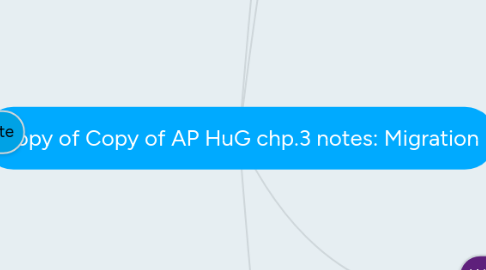
1. Why do people migrate
1.1. Forced migration by greater power
1.1.1. The most devastating forced migration in history was the slave trade
1.1.2. Most of the slaves actually went to the Caribbean
1.1.3. Slave trade damaged many regions in Africa
1.1.4. Great Britain shipped prisoners to Africa
1.1.5. Nazis relocated Jews
1.1.6. Many forced migrations still happen today
1.2. Voluntary migration
1.2.1. Push and pull factors
1.2.1.1. Laws of migration
1.2.1.2. The gravity model which predicts the interaction between places on the basis of their population size and distance between them
1.2.1.3. Push factors are reasons to leave
1.2.1.4. Pull factors are reasons to stay
1.2.1.5. Migrants will perceive push factors more accurately then pull factors
1.2.1.6. Distance decay is when people tend to have clearer perceptions of places nearer to them
1.2.1.7. Step migration is when a person/family step by step moves to a more urban place
1.2.1.8. Intervening opportunities
1.2.2. Types of push and pull factors
1.2.2.1. Legal status can determine wether or not you can migrate to a given country, if you are illegally thee you are at risk of deportation
1.2.2.2. The economic conditions of their homeland can be a determining factor
1.2.2.3. Gender ethnicity race and money can all be key factors
1.3. At a household scale the decision is made by a cooperative conflict bargaining process
1.4. People can be politically driven from a country
1.5. Environmental conditions can drive people from countries due to natural disasters or extreme weather including things like volcanoes hurricanes and earthquakes
1.6. Culture and traditions can affect migration decisions
1.7. Technological advances can make it much easier for people to migrate
1.8. Kinship links can cause people to migrate and flows along and through kinship links are called chain migration, chains of migration built up can create immigration waves
2. What is migration?
2.1. Cyclic movement involves shorter periods of time from home
2.1.1. Cyclic movement within activity spaces
2.1.2. Commuting to work is cyclic
2.1.3. Nomadism is cyclic
2.2. Periodic movement involves much longer periods away from home
2.2.1. Migrant labor
2.2.2. Transhumance is where farmers move with the livestock depending on availability of pastures
2.2.3. Military service
2.3. With migration one never returns home
2.3.1. International migration when you move across the borders of countries
2.3.2. Internal migration is within a country
3. Field note
3.1. Haitians try to escape to the U.S. For a better life as do many other people across the world.
3.2. Coast guards can board any Haitian vessel in order to prevent illegal immigration.
3.3. Governments have a great impact on migration
3.4. Perception gives people the desire to migrate
3.5. Remittances are the money people send home to families
3.5.1. Reverse remittances are when money is sent to the U.S. From Mexico
3.6. Millions of undocumented migrants in the U.S.
3.6.1. Many migrants are legal though
3.7. Canada and US recruit workers from Mexico
4. Where do people migrate
4.1. Global migration flows
4.1.1. Global-scale migration was rare before 1500
4.1.2. European colonization started the exploration of the world
4.1.3. After 1500 there was a large amount of migration among many countries
4.1.4. During this time many people were transferred to other places against their will such as slaves and indentured workers the India region
4.2. Regional migration foows
4.2.1. Migration also occurs at the Regional scale
4.2.2. Developed cities in a poorer region are called islands of development
4.2.3. If we use both regional and global scales we can understand economic influences
4.2.4. Southeast Asia opened up job opportunities for Chinese workers causing mass migration of 2 million people
4.2.5. At the end of WW2 15 million Germans fled from Europe both voluntarily or forced
4.2.6. Sometimes migration flows can be the cause of the movement of cultural groups
4.2.7. National migration flows are internal migration flows
4.2.8. After the civil war millions of African Americans moved north for better jobs, then the opposite happened in the 1970s
4.2.9. Jews fled from Palestine but were later encouraged to return
4.2.10. Russia created policy of Russification attempting to enforce the Russian culture
4.2.11. Mexicans migrate both legally and illegally into the U.S. Every year
4.2.12. Labor migrants are called guest workers
4.2.12.1. There are millions of guest workers who live outside their home countries to work
4.2.12.2. When need for labor declines guest workers are squeaked out by the government
4.2.12.3. Legal migrants with work visas
4.2.13. Refugees
4.2.13.1. No food, water, clothes
4.2.13.2. In 2010 there were 15.2 million refugees
4.2.13.3. Internally displaced people are people displaced within their own countries
4.2.13.4. Refugees have the right to asylum and protection from the first country that the refugee arrives
4.2.13.5. Repatriation is the process of returning refugees to their home country's
4.2.13.6. Regions of dislocation
4.2.13.6.1. North Africa and Southwest Asia
4.2.13.6.2. Africa
4.2.13.6.3. South Asia 3 million
4.2.13.6.4. Southeast Asia 1-2 million
4.2.13.6.5. Europe 100,00
5. How do governments affect migration
5.1. The U.S. And Australia created immigration laws preventing certain people from immigrating to certain places
5.2. Waves of immigration in the up US
5.2.1. 1800s Europeans
5.2.2. Congress set immigration quotas where European countries could only send three percent of its nationals to the U.S.
5.2.3. Us kept further limiting migration throughout the 1900s

